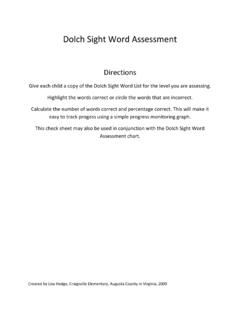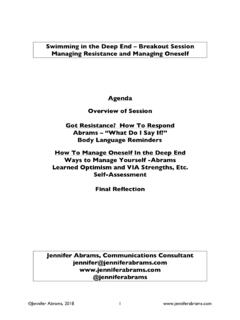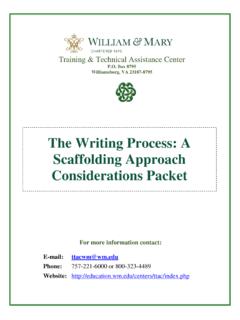Transcription of Inferential Reading Comprehension Considerations Packet
1 Training & Technical Assistance Center Box 8795 Williamsburg, VA 23187-8795 Inferential Reading Comprehension Considerations Packet For more information contact: E-mail: Phone: 757-221-6000 or 800-323-4489 Website: Considerations : Inferential Comprehension T/TAC W&M 2002 2 Inferring supporting details guessing about additional facts the author could have included in the selection that would have made it more informative, interesting, or appealing Inferring the main idea providing the main idea, general significance, theme, or moral that is not explicitly stated in the selection Inferring sequence guessing what action or incident might have taken place between two explicitly stated actions or incidents or making hypotheses about what could happen next Inferring comparisons inferring likenesses and differences in characters, times.
2 Or places Inferring cause-and-effect relationships hypothesizing about the motives of characters and their interactions with others and with time and place Inferring character traits hypothesizing about the nature of characters on the basis of explicit clues presented in the selection predicting outcomes guessing the outcome of a selection after Reading an initial portion of it Inferring about figurative language inferring literal meanings from the author s figurative use of language. Explicit Instruction for Implicit Meaning: Strategies for Teaching Inferential Reading Comprehension The No Child Left Behind Act of 2001 promotes use of scientifically based research to provide high-quality Reading instruction to help all students become successful readers.
3 Comprehension is a key component of this literacy initiative; facility in literal, Inferential , critical, and creative Comprehension skills is critical to Reading success and academic achievement in all content areas. This Packet focuses on research-based strategies teachers may employ to improve students Inferential Comprehension skills. Topics include the meaning of the term Inferential Comprehension , specific subskills necessary for making inferences, suggestions for teaching students to make inferences, and ideas for providing a variety of opportunities for students to practice the skill of Inferential Comprehension . Introduction Inferential Comprehension is often described simply as the ability to read between the lines.
4 It requires a reader to blend the literal content of a selection with prior knowledge, intuition, and imagination for conjecture or to make hypotheses. Barrett s Taxonomy of Reading Comprehension (1974) identifies the following eight subtasks that enable students to make inferences with facility. Stated differently, Keene and Zimmerman (1997) observed that when proficient readers infer, they: Considerations : Inferential Comprehension T/TAC W&M 2002 3 Draw conclusions from text Make reasonable predictions as they read, test and revise those predictions as they read further Create dynamic interpretations of text that are adapted as they continue to read Use the combination of background knowledge and explicitly stated information from the text to answer questions they have as they read Make connections between conclusions they draw and other beliefs or knowledge Make critical or analytical judgments about what they read Proficient readers are better able to remember and apply what they have read.
5 Create new background knowledge for themselves, discriminate and critically analyze text and authors, and engage in conversation and/or other analytical responses to what they read. Conversely, struggling readers have difficulty with some or all of these Comprehension skills. Fortunately, the results of many studies associated with Comprehension strategies ( , Lenz & Hughes, 1990; Scanlon, Deshler, & Shumaker, 1996; Shumaker, Deshler, Alley, Warner, & Denton, 1982) indicate that students with high-incidence disabilities can learn to mediate their Comprehension of Reading material through intensive, systematic, and explicit instruction in learning strategies.
6 Research conducted in the 1970s concluded that classroom teachers were spending very little time on the actual process of teaching Reading Comprehension . For example, Durkin (1978-1979) found that although teachers gave many workbook assignments and asked many questions about what students had read, these exercises usually assessed students understanding rather than teaching them how to comprehend. In response to Durkin s findings, much subsequent research during the 1980s was devoted to discovering how to teach Comprehension strategies directly. One widely researched model, explicit instruction, involves four phases: Teacher explanation and modeling of a strategy Guided practice during which teachers gradually give students more responsibility for task completion Independent practice accompanied by feedback Application of the strategy in real Reading situations (Fielding & Pearson, 1994).
7 Indeed, as Pearson and Duke (2002) point out, Comprehension improves when teachers provide explicit instruction in the use of Comprehension strategies. Comprehension improves when teachers implement activities that support the understanding of the text that students will read in their classes (p. 247). The material that follows provides suggestions for introducing to students the concept of making inferences and showcases strategies for explicit instruction of Inferential Comprehension skills. Considerations : Inferential Comprehension T/TAC W&M 2002 4 Correlation of Strategies to Barrett s Taxonomy of Reading Comprehension What Is It?
8 Cucumber Cues Backwards Words Think-Aloud Who s Who? QAR Local Fun and Games Cloze Procedure DRTA Reciprocal Teaching Picture This! Simple Sentences Cartoon Commentary Sequencing Text Sequencing with Music Sequencing Directions Detective Justifying Answers Acting Out Figure It Out! Figurative Language Ads Figurative Language Artwork Graphic Organizers Open Mind Personality Traits Considerations : Inferential Comprehension T/TAC W&M 2002 5 What is It?
9 (Adapted from Reading Workshop, n. d.) 1. Introduce an object with which students may be unfamiliar, for example, an apple corer. Ask them to infer the object s purpose. 2. After several guesses, introduce a second object with which the first object is used; for example in this case, an apple. Continue to ask students to make inferences about the purpose of the first object. 3. Show students how the first object is used with the second object in other words, core the apple. 4. Ask students who correctly guessed the purpose of the first object (the corer) to explain how the introduction of the second object (the apple) helped them infer its purpose.
10 Explain that using information they already know can help students grasp the meaning of information they do not know. Other suggested object pairs follow. Show a nutcracker. Ask students to make an inference for what is it used? After several guesses, introduce an unshelled nut. Show an olive pitter. Ask students to make an inference for what is it used? After several guesses, introduce a bowl of olives. Cucumber Cues 1. Provide students with sentences in which one word has been replaced by the word cucumber. (The teacher may read each sentence to nonreaders.) 2. Ask students to write or say the sentences, changing cucumber to a word that makes better sense.










